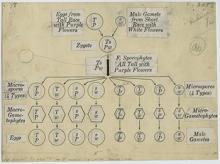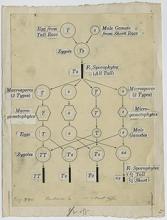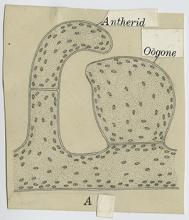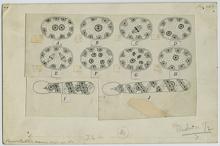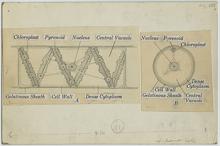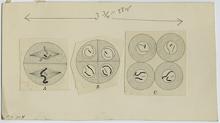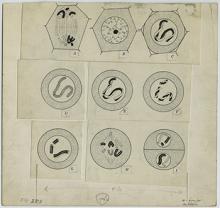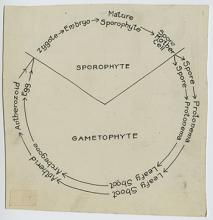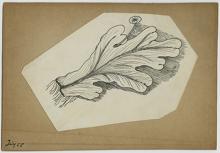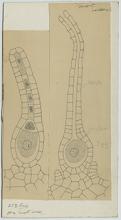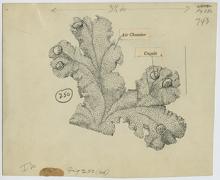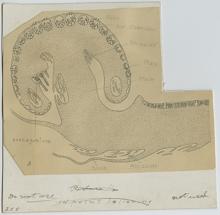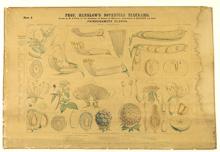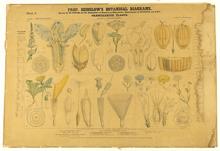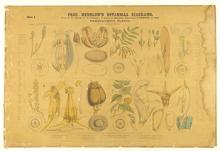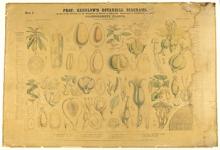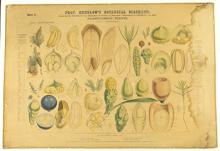Accession Number: 6865.981
Artist Name: Smith, Gilbert Morgan
Nationality: United States
Image (click image to view):
Title: Diagram illustration the inheritance of tallness and shortness in Mendel’s experiments with peas.
Dimensions (cm): 14.7 x 19
Published: Smith, G., J. B. Overton, E. M. Gilbert, R. H. Denniston, G. S. Bryan, and C. E. Allen. 1937. A Textbook of Botany, ed. 3. New York: Macmillan Company. Fig. 391.
Accession Number: 6865.982
Artist Name: Smith, Gilbert Morgan
Nationality: United States
Image (click image to view):
Title: Fig. 395. Diagram illustrating the transmission of 2 pairs of genes, borne on different pairs of chromosomes. Each original parent contributed, through its gamete, 1 chromosome of each pair. Chromosomes of 1 pair bear respectively genes for tallness (T) and for shortness (s); those of the other pair, genes for purple (P) and for white (w). The F1 sporophyte produces 4 types of macrospores and 4 types of microspores. These spores give rise to macrogametophytes of 4 types, producing each its own type of male gamete.
Dimensions (cm): 15.3 x 20.5
Published: Smith, G., J. B. Overton, E. M. Gilbert, R. H. Denniston, G. S. Bryan, and C. E. Allen. 1937. A Textbook of Botany, ed. 3. New York: Macmillan Company. Fig. 395.
Accession Number: 6865.983
Artist Name: Smith, Gilbert Morgan
Nationality: United States
Image (click image to view):
Title: Fig. 394. Diagram illustrating the transmission of genes for tallness and shortness, borne on chromosomes of 1 pair. Each original parent contributed, through its gamete, 1 chromosome of the pair. The 2 chromosomes are separated in the reduction divisions, half the macrospores and half the microspores receiving the chromosome bearing a gene for tallness, the other half of the macrospores and microspores receiving the chromosome bearing a gene for shortness. These spores give rise to gametophytes, and these to gametes, containing corresponding chromosomes; hence there are 2 kinds of eggs and 2 kinds of male gametes. The result of hap-hazard unions between eggs and male gametes is the production of zygotes, and hence of sporophytes, of which ¼ have 2 genes each for tallness, ½ have each 1 gene for tallness and 1 gene for shortness, ¼ have each 2 genes for shortness. Sporophytes of the first 2 classes are tall, tallness being dominant; those of the third class are short.
Support: paper mounted on paper
Dimensions (cm): 23 x 17.3
Published: Smith, G., J. B. Overton, E. M. Gilbert, R. H. Denniston, G. S. Bryan, and C. E. Allen. 1937. A Textbook of Botany, ed. 3. New York: Macmillan Company. Fig. 394.
Accession Number: 6865.984
Artist Name: Smith, Gilbert Morgan
Nationality: United States
Image (click image to view):
Dimensions (cm): 5.1 x 14.1
Notes: Perhaps for an edition of G. M. Smith, et. al. A Textbook of General Botany. Figs. A., B., C.
Accession Number: 6865.985
Artist Name: Smith, Gilbert Morgan
Nationality: United States
Image (click image to view):
Title: Fig. 120. Types of thalli found among the red algae. A, the tough, thick thallus of Gigartina. B, the feathery thallus of Polysiphonia. C, the thin, leaf-like thallus of Grinnellia.
Taxon: Gigartina Stackhouse, Gigartinaceae; Polysiphonia R. Greville, Rhodomelaceae; Grinnellia W. H. Harvey, Delesseriaceae
Support: [3 individual drawings] mounted on board
Dimensions (cm): 14.3 x 22.8
Published: Smith, G. M., J. B. Overton, E. M. Gilbert. R. H. Denniston, G. S. Bryan and C. E. Allen. 1927. A Textbook of General Botany, ed. 1. New York: The Macmillan Company. Fig. 120.
Accession Number: 6865.986
Artist Name: Smith, Gilbert Morgan
Nationality: United States
Image (click image to view):
Title: Fig. 161. Vaucheria. A, young sex organs.
Taxon: Vaucheria A. P. de Candolle, Vaucheriaceae
Published: Smith, G., J. B. Overton, E. M. Gilbert, R. H. Denniston, G. S. Bryan, and C. E. Allen. 1937. A Textbook of Botany, ed. 3. New York: Macmillan Company. Fig. 161a.
Notes: Antherid and Oögone
Accession Number: 6865.987
Artist Name: Smith, Gilbert Morgan
Nationality: United States
Image (click image to view):
Title: Fig. 161. Vaucheria. B, sex organs at a later stage; the antheridium empty, the oögonium containing a zygote
Taxon: Vaucheria A. P. de Candolle, Vaucheriaceae
Dimensions (cm): 9.4 x 10.6
Published: Smith, G., J. B. Overton, E. M. Gilbert, R. H. Denniston, G. S. Bryan, and C. E. Allen. 1937. A Textbook of Botany, ed. 3. New York: Macmillan Company. Fig. 161b.
Accession Number: 6865.988
Artist Name: Smith, Gilbert Morgan
Nationality: United States
Image (click image to view):
Title: Fig. 154. Diagrams showing stages in the history of a zygote of Spirogyra; A-H in section ; I, J in surface view. A, zygote just after the union of gametes; gamete nuclei still separate. B, male and female nuclei have united. C, first nuclear division in the zygote, forming 2 nuclei (D). E, second nuclear division, forming 4 nuclei (F). G, 3 nuclei beginning to disintegrate. H, after the disappearance of 3 nuclei. I, J, stages in the germination of a zygote.
Taxon: Spirogyra Link, Zygnemataceae
Dimensions (cm): 15 x 22.8
Published: Smith, G., J. B. Overton, E. M. Gilbert, R. H. Denniston, G. S. Bryan, and C. E. Allen. 1937. A Textbook of Botany, ed. 3. New York: Macmillan Company. Fig. 154.
Accession Number: 6865.989
Artist Name: Smith, Gilbert Morgan
Nationality: United States
Image (click image to view):
Taxon: Spirogyra Link, Zygnemataceae
Description: cell of spirogyra
Dimensions (cm): 7.5 x 22.2
Notes: "Don’t use, substitute fig. 152" written in pencil [see accession no. 6865.990]
Accession Number: 6865.990
Artist Name: Smith, Gilbert Morgan
Nationality: United States
Image (click image to view):
Taxon: Spirogyra Link, Zygnemataceae
Description: A, Chloroplast, pyrenoid, nucleus, central vacuole, gelatinous sheath, cell wall, dense cytoplasm. B, nucleus, pyrenoid, chloroplast, cell wall, gelatinous sheath, dense cytoplasm, central vacuole
Support: paper [2 individual drawings] mounted on board
Dimensions (cm): 15.1 x 22.7
Published: Smith, G., J. B. Overton, E. M. Gilbert, R. H. Denniston, G. S. Bryan, and C. E. Allen. 1937. A Textbook of Botany, ed. 3. New York: Macmillan Company. Fig. 152.
Accession Number: 6865.991
Artist Name: Smith, Gilbert Morgan
Nationality: United States
Image (click image to view):
Title: Fig. 204. Diagrams illustrating the second reduction division. A, the equatorial-plate stage. B, completion of the second division; four spores are now present, each with 3 (n) chromosomes. C, separation and rounding up of the spores.
Support: paper [3 individual drawings] mounted on board
Dimensions (cm): 12.5 x 22.8
Published: Smith, G. M., J. B. Overton, E. M. Gilbert. R. H. Denniston, G. S. Bryan and C. E. Allen. 1927. A Textbook of General Botany, ed. 1. New York: The Macmillan Company. Fig. 204.
Accession Number: 6865.992
Artist Name: Smith, Gilbert Morgan
Nationality: United States
Image (click image to view):
Title: Fig. 284. Second reduction division. A, equatorial-plate stage. B, completion of the second division; each of the 4 spores contains n chromosomes. C, separation and rounding up of spores.
Support: paper [3 individual drawings] mounted on board
Dimensions (cm): 15.2 x 22.7
Published: Smith, G., J. B. Overton, E. M. Gilbert, R. H. Denniston, G. S. Bryan, and C. E. Allen. 1937. A Textbook of Botany, ed. 3. New York: Macmillan Company. Fig. 284.
Accession Number: 6865.993
Artist Name: Smith, Gilbert Morgan
Nationality: United States
Image (click image to view):
Title: Fig. 283. Diagram illustration the formation of spore mother cells and the first reduction division. A, division of which spore mother cells are formed; 2 n chromosomes pass to each daughter nucleus (n being considered as 3). B, spore mother cell; nucleus in the resting stage. C, pairing of chromosomes; n pairs are present. D, the chromosomes of each pair in intimate contact. E, paired chromosomes are again visibly separate. F, the chromosomes have contracted. G, the chromosomes are now plainly split. H, separation of whole (but split) chromosomes after the equatorial-plate stage. I, the 2 daughter cells, each containing n split chromosomes.
Support: paper [5 individual drawings] mounted on board
Dimensions (cm): 21.6 x 22.7
Published: Smith, G., J. B. Overton, E. M. Gilbert, R. H. Denniston, G. S. Bryan, and C. E. Allen. 1937. A Textbook of Botany, ed. 3. New York: Macmillan Company. Fig. 283.
Accession Number: 6865.994
Artist Name: Smith, Gilbert Morgan
Nationality: United States
Image (click image to view):
Title: Fig. 198. The life cycle of a moss.
Dimensions (cm): 13 x 12.5
Published: Smith, G. M., J. B. Overton, E. M. Gilbert. R. H. Denniston, G. S. Bryan and C. E. Allen. 1927. A Textbook of General Botany, ed. 1. New York: The Macmillan Company. Fig. 198.
Accession Number: 6865.995
Artist Name: Smith, Gilbert Morgan
Nationality: United States
Image (click image to view):
Support: paper mounted on board
Dimensions (cm): 12.2 x 17.6
Notes: Perhaps for an edition of G. M. Smith, et. al. A Textbook of General Botany. Fig. 5[5], 5[6] or 5[8]? [illegible]
Accession Number: 6865.996
Artist Name: Smith, Gilbert Morgan
Nationality: United States
Image (click image to view):
Support: paper [2 individual drawings] mounted on board
Dimensions (cm): 21.4 x 11.5
Notes: Perhaps for an edition of G. M. Smith, et. al. A Textbook of General Botany; "258 bis, do not use, not used" written in pencil
Accession Number: 6865.997
Artist Name: Smith, Gilbert Morgan
Nationality: United States
Image (click image to view):
Title: Fig. 252. Thallus of Marchantia bearing cupules in which gemmae are produced.
Taxon: Marchantia Linnaeus, Marchantiaceae
Dimensions (cm): 20.3 x 18.7
Published: Smith, G., J. B. Overton, E. M. Gilbert, R. H. Denniston, G. S. Bryan, and C. E. Allen. 1937. A Textbook of Botany, ed. 3. New York: Macmillan Company. Fig. 252.
Accession Number: 6865.998
Artist Name: Smith, Gilbert Morgan
Nationality: United States
Image (click image to view):
Title: [Thallus of Marchantia bearing cupules in which gemmae are produced.]
Taxon: Marchantia Linnaeus, Marchantiaceae
Dimensions (cm): 15.4 x 18.8
Published: Smith, G. M., J. B. Overton, E. M. Gilbert. R. H. Denniston, G. S. Bryan and C. E. Allen. ?. A Textbook of General Botany, ed. 2. New York: The Macmillan Company. Fig. 250.
Accession Number: 6865.999
Artist Name: Smith, Gilbert Morgan
Nationality: United States
Image (click image to view):
Description: Archegonium, pore, air chamber, rhizoids, ray, stalk, rhizoids, scale
Support: paper mounted on board
Dimensions (cm): 18.7 x 19.2
Notes: Handwritten in pencil "258, not used, do not use"; similar to Fig. 281. Marchantia. Vertical section of a male branch and of a portion of the thallus in A Textbook of General Botany, 4th edition (1942).
Accession Number: 6866.1
Artist Name: Fitch, Walter Hood
Image (click image to view):
Copyright: To publish this image, contact the Hunt Institute Art Department
Title: ''Sheet 1. Class 1. Dicotyledons. Division I. Angiospermous. I. Order Ranunculanths. Ranunculaceae. (1.) Bulbous Ranunculus. Ranunculus bulbosus. (2.) Water Ranunculus. Ranunculus aquatilis. II. Order Brassicanths or Crucifers. Cruciferae. (1.) Common wallflower. Cheiranthus cheiri. (2.) Common shepherd's-purse. Capsella bursa-pastoris. (3.) Annual honesty. Lunaria biennis. (4.) Garden radish. Raphanus sativus. (5.) Field pepperwort. Lepidium campestre. (6.) Oriental Bunias. Bunias orientalis. (7.) Samphire-leaved Heliophila. Heliophila erithmifolia. III. Order Malvanths. Malvaceae. Common mallow. Malva sylvestris. IV. Order Hypericanths. Hypericaceae. Perforated St.-John's-wort. Hypericum perforatum''
Taxon: Bunias, Brassicaceae alt. Cruciferae
Capsella, Brassicaceae alt. Cruciferae
Cheiranthus, Brassicaceae alt. Cruciferae
Heliophila, Brassicaceae alt. Cruciferae
Hypericum, Clusiaceae alt. Guttiferae
Malva, Malvaceae
Ranunculus, Ranunculaceae
Raphanus, Brassicaceae alt. Cruciferae
Medium: lithograph, color
Support: paper backed with canvas
Dimensions (cm): 71 x 100
Published: from Prof. Henslow's Botanical Diagrams. Drawn by W. Fitch, for the Committee of Council on Education: Department of Science and Art. Phaenogamous plants. Day & Son, 1857.
Notes: Wall chart. One of 9 sheets covering systematics. Based on the drawings of John Stevens Henslow (1796–1861) and his eldest daughter Anne Barnard. The Hunt Institute has a complete set.
Accession Number: 6866.2
Artist Name: Fitch, Walter Hood
Image (click image to view):
Copyright: To publish this image, contact the Hunt Institute Art Department
Title: ''Sheet 2. Class 1. Dicotyledons. Division I. Angiospermous. V. Order Vicianths, or Legumens. Leguminosae. (1.) Garden pea. Pisum sativum. (2.) European Judas tree. Cercis siliquastrum. (3.) Common broom. Sarothamnus scoparius. (4.) Broad-winged Acacia. Acacia platyptera. VI. Order Rosanths. Rosaceae. (1.) Blackberry Rubus. Rubus fruticosus. (2.) Common prunus (var. bullace). Prunus comunis (var. institia). (3.) Wood strawberry. Fragaria vesca. (4.) Dog rose. Rosa canina. (5.) Apple Pyrus. Pyrus malus''
Taxon: Acacia, Fabaceae alt. Leguminosae
Cercis, Fabaceae alt. Leguminosae
Fragaria, Rosaceae
Pisum, Fabaceae alt. Leguminosae
Prunus, Rosaceae
Pyrus, Rosaceae
Rosa, Rosaceae[[Rubus, Rosaceae
Sarothamnus, Fabaceae alt. Leguminosae
Medium: lithograph, color
Support: paper backed with canvas
Dimensions (cm): 71 x 100
Published: from Prof. Henslow's Botanical Diagrams. Drawn by W. Fitch, for the Committee of Council on Education: Department of Science and Art. Phaenogamous plants. Day & Son, 1857.
Notes: Wall chart. One of 9 sheets covering systematics. Based on the drawings of John Stevens Henslow (1796–1861) and his eldest daughter Anne Barnard. The Hunt Institute has a complete set.
Accession Number: 6866.3
Artist Name: Fitch, Walter Hood
Image (click image to view):
Copyright: To publish this image, contact the Hunt Institute Art Department
Title: ''Sheet 3. Class 1. Dicotyledons. Division I. Angiospermous. VII. Order Lythranths. Lythraceae. Spiked Lythrum. Lythrum salicaria. VIII. Order Apianths or Umbellifers. Umbelliferae. Common Heracleum. Heracleum spondylium. IX. Asteranths or composites. Compositae. (1.) Common dandelion. Leontodon taraxicum. (2.) Spear thistle. Carduus lanceolatus. (3.) Great globe-thistle. Echinops sphaerocephalus. (4.) Corn Centaurea. Centaurea cyanus. (5.) Stinking chamomile. Anthemis cotula. (6.) Common marigold. Calendula officinalis. X. Order Dipsacanths. Dipsacaceae. Field Knautia. Knautia arvensis''
Taxon: Anthemis, Asteraceae alt. Compositae
Calendula, Asteraceae alt. Compositae
Carduus, Asteraceae alt. Compositae
Centaurea, Asteraceae alt. Compositae
Echinops, Asteraceae alt. Compositae
Heracleum, Apiaceae alt. Umbelliferae
Knautia, Dipsacaceae
Leontodon, Asteraceae alt. Compositae
Lythrum, Lythraceae
Medium: lithograph, color
Support: paper backed with canvas
Dimensions (cm): 71 x 100
Published: from Prof. Henslow's Botanical Diagrams. Drawn by W. Fitch, for the Committee of Council on Education: Department of Science and Art. Phaenogamous plants. Day & Son, 1857.
Notes: Wall chart. One of 9 sheets covering systematics. Based on the drawings of John Stevens Henslow (1796–1861) and his eldest daughter Anne Barnard. The Hunt Institute has a complete set.
Accession Number: 6866.4
Artist Name: Fitch, Walter Hood
Image (click image to view):
Copyright: To publish this image, contact the Hunt Institute Art Department
Title: ''Sheet 4. Class 1. Dicotyledons. Division I. Angiospermous. XI. Order Ericanths. Ericaceae. Fine-leaved heath. Erica cinerea. XII. Order Oleanths. Oleraceae. (1.) Common ash. Fraxinus excelsior. (2.) Flowering ash. Fraxinus ornus. (3.) Common lilac. Syringa vulgaris. XIII. Order Scropohularianths. Scrophulariaceae. Yellow Linaria. Linaria vulgaris. XIV. Order Lamianths or Labiates. Labiatae. (1.) White Lamium. Lamium album. (2.) Spreading-flowered sage. Salvia patens''
Taxon: Erica, Ericaceae
Fraxinus, Oleaceae
Lamium, Lamiaceae alt. Labiatae
Linaria, Scrophulariaceae
Salvia, Lamiaceae alt. Labiatae
Syringa, Oleaceae
Medium: lithograph, color
Support: paper backed with canvas
Dimensions (cm): 71 x 100
Published: from Prof. Henslow's Botanical Diagrams. Drawn by W. Fitch, for the Committee of Council on Education: Department of Science and Art. Phaenogamous plants. Day & Son, 1857.
Notes: Wall chart. One of 9 sheets covering systematics. Based on the drawings of John Stevens Henslow (1796–1861) and his eldest daughter Anne Barnard. The Hunt Institute has a complete set.
Accession Number: 6866.5
Artist Name: Fitch, Walter Hood
Image (click image to view):
Copyright: To publish this image, contact the Hunt Institute Art Department
Title: ''Sheet 5. Class 1. Dicotyledons. Division 1. Angiospermous. XV. Order Thymelanths. Thymelaceœ. Spurge Daphne. Daphne laureola. XVI. Order Euphorbianths. Euphorbiaceae. (1.) Perennial mercury. Mercurialis perennis. (2.) Wood spurge. Euphorbia amygdaloides. XVII. Order Urticanths. Urticaceae. (1.) Small nettle. Urtica urens. (2.) Common mulberry. Morus nigra. (3.) Common fig. Ficus carica. XVIII. Order Corylanths, or Amentifers. Amentiferae. (1.) Common hazel. Corylus avellana. (2.) Sallow willow. Salix capraea''
Taxon: Corylus, Betulaceae
Daphne, Thymelaeaceae
Euphorbia, Euphorbiaceae
Ficus, Moraceae
Mercurialis, Euphorbiaceae
Morus, Moraceae
Salix, Salicaceae
Urtica, Urticaceae
Medium: lithograph, color
Support: paper backed with canvas
Dimensions (cm): 71 x 100
Published: from Prof. Henslow's Botanical Diagrams. Drawn by W. Fitch, for the Committee of Council on Education: Department of Science and Art. Phaenogamous plants. Day & Son, 1857.
Notes: Wall chart. One of 9 sheets covering systematics. Based on the drawings of John Stevens Henslow (1796–1861) and his eldest daughter Anne Barnard. The Hunt Institute has a complete set.
Accession Number: 6866.6
Artist Name: Fitch, Walter Hood
Image (click image to view):
Copyright: To publish this image, contact the Hunt Institute Art Department
Title: ''Sheet 6. Class 1. Dicotyledons. Division I. Gymnospermous. XIX Order Pinanths or Conifers. Coniferae. (1.) Scotch fir. Pinus sylvestris. (2.) Common cypress. Cupressus sempervirens. (3.) Common juniper. Juniperus communis. (4.) Common yew. Taxus baccata''
Taxon: Cupressus, Pinaceae
Juniperus, Pinaceae
Pinus, Pinaceae
Taxus, Taxaceae
Medium: lithograph, color
Support: paper backed with canvas
Dimensions (cm): 71 x 100
Published: from Prof. Henslow's Botanical Diagrams. Drawn by W. Fitch, for the Committee of Council on Education: Department of Science and Art. Phaenogamous plants. Day & Son, 1857.
Notes: Wall chart. One of 9 sheets covering systematics. Based on the drawings of John Stevens Henslow (1796–1861) and his eldest daughter Anne Barnard. The Hunt Institute has a complete set.


